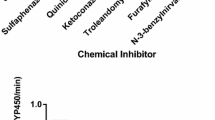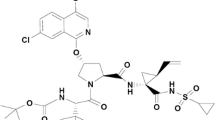Abstract
Objective: Biotransformation of triazolam to its α-hydroxy and 4-hydroxy metabolites by human liver microsomes in vitro was used as an index of human cytochrome P 450 3A (CYP3A) activity.
Results: The reaction was strongly inhibited by co-incubation with the viral protease inhibitors ritonavir (IC50=0.14 μM) and amprenavir (IC50=2.5–2.9 μM), and by the azole derivative ketoconazole (IC50 = 0.07 μM). Pre-incubation of microsomes with ritonavir or amprenavir increased inhibitory potency (IC50 reduced to 0.07 μM and 1.4 μM, respectively). This was not the case with ketoconazole.
Conclusions: Thus, ritonavir and amprenavir are highly potent mechanism-based inhibitors of human CYP3A isoforms.
Similar content being viewed by others
Author information
Authors and Affiliations
Additional information
Received: 11 January 2000 / Accepted in revised form: 9 March 2000
Rights and permissions
About this article
Cite this article
von Moltke, L., Durol, A., Duan, S. et al. Potent mechanism-based inhibition of human CYP3A in vitro by amprenavir and ritonavir: comparison with ketoconazole. E J Clin Pharmacol 56, 259–261 (2000). https://doi.org/10.1007/s002280000125
Issue Date:
DOI: https://doi.org/10.1007/s002280000125




